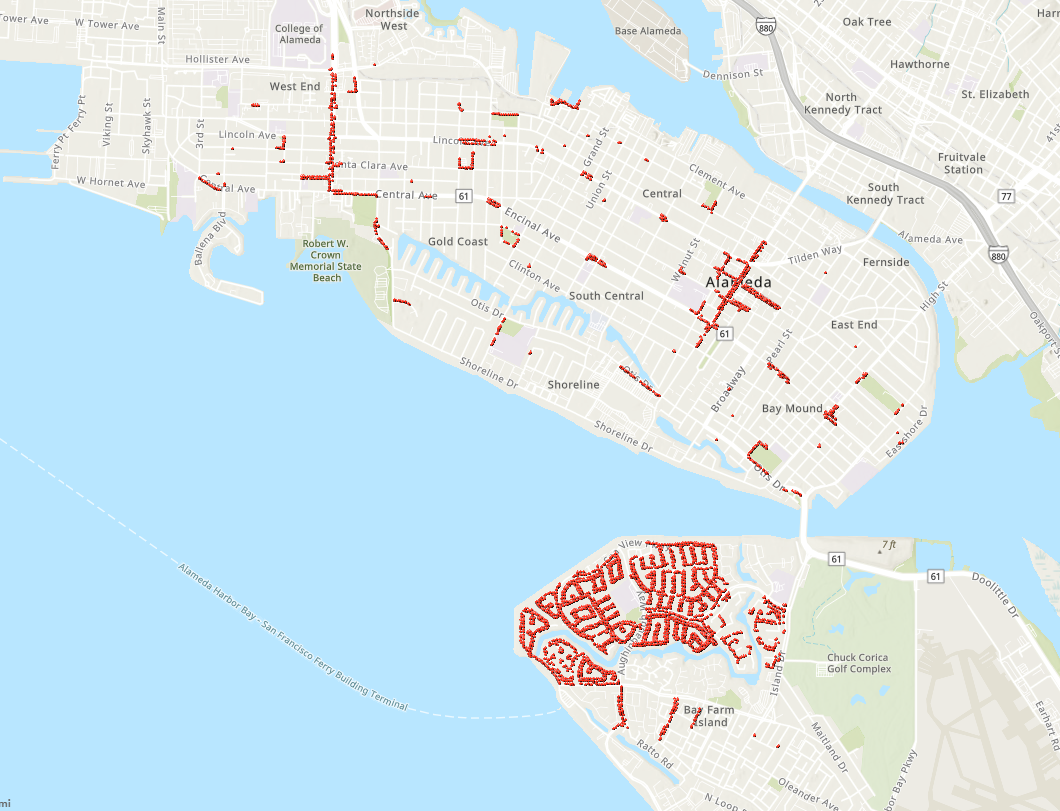
The sidewalk system is a vital component of the city’s infrastructure and plays an essential role in city life as they enhance connectivity and promote walking. As public spaces, they activate streets socially and economically. Safe, accessible, and well-maintained sidewalks are fundamental to mobility and healthy communities.
Over time concrete sidewalks have a tendency to shift and settle creating offsets between concrete panels. In addition, as trees grow and mature, site conditions can result in tree roots raising the sidewalk, curb, gutter, and pavement area. While the Alameda Municipal Code (AMC) identifies the adjacent property owner as being responsible for maintaining the sidewalk, curb, gutter, and driveway approaches, the City’s long standing practice is to repair sidewalk damaged by street trees, all other repairs are the responsibility of the property owner.
Sidewalk Repair Program
About the Program
Sidewalk repairs can be costly and are often unexpected if the owner is not aware of their responsibility. Finding a contractor and getting permits can also place a burden on the property owner. To help promote more sidewalk repair work, the City launched a pilot program in January 2025 where the City offers an option for the City do the repair work on the property owner’s behalf and send them an invoice. This makes the repair process much simpler, allows potential economies of scale in pricing, removes the need to find a contractor and to get a permit. The program also has a financial hardship provision for qualifying property owners to either have the cost waived or paid on a sliding scale.
How the Program Works
- The City becomes aware of sidewalk defects through routine inspections or resident complaints (phone call or report on SeeClickFix).
- If the defect was caused by a street tree, the City will make the repair.
- If the defect can be addressed with concrete cutting, regardless of cause, the City will make the repair. Concrete cutting is a cost-effective way to cleanly remove trip hazards from sidewalks. The raised sidewalk will be cut from edge to edge horizontally giving the offset a ramping effect and eliminating the trip hazard (note: cutting is not appropriate for all sidewalk defects).
- If the defect requires removal/replacement of concrete and is not caused by a street tree, the property owner is notified that they must make repairs and is given the option of using the City’s Sidewalk Repair Program. An estimate of cost for the City to make the repairs is provided in the notification.
- If a property owner chooses to participate in the program, the City schedules the repair work with the contractor, manages the project to completion and invoices the property owner.
Want to participate in the Program?
To take advantage of the program contact the ADA Coordinator at 510-747-7961 or send us an email at sidewalks@alamedaca.gov.


Other Information about Sidewalk Repairs
How does the City fund sidewalk repair work?
In this capital budget, 2024-2025, funding for sidewalk repair comes from two sources: Measure B/BB Local Streets and Roads and General Funds. In 2000, nearly 82 percent of Alameda County voters approved Measure B, the half-cent transportation sales tax. The Alameda County Transportation Commission administers Measure B funds to deliver essential transportation improvements and services. Regional priorities are to:
- Expand mass transit.
- Improve highway infrastructure.
- Improve local streets and roads.
- Improve bicycle and pedestrian safety.
- Expand special transportation for seniors and people with disabilities.
The City of Alameda receives Measure B direct local distributions to meet these regional priorities. Some of the local distribution received goes towards sidewalk repair. In 2014, Alameda County voters approved Measure BB, authorizing an extension and augmentation of the existing transportation sale tax.
City Council invested an additional $2 million in sidewalks for Fiscal Year 2024-25.
What type of sidewalk repairs are there?
To optimize the use of available funding, the City uses concrete cutting, a technology where vertical offset sidewalks are cut instead of a complete removal and replacement, when possible. Concrete cutting allows us to make the most use out of the existing concrete, which is better for the environment, and allows for a cost-effective repair that has a reliable standard of quality and is accurately sloped to meet Americans with Disability Act (ADA) standards. Although the cause of the uplift—differential settlement or tree roots—is not addressed with concrete cutting, it removes the tripping hazard and extends the time before the remove and replace work must be done.
With Council's investment of General Funds, the City recently started cutting all trip hazards, regardless of cause, as a quick and effective means of removing hazard. For trip hazards caused by City trees that cannot be cut, the City removes and replaces the concrete sidewalk. Depending on site specific circumstances, the tree may or may not require removal.

Where is the repair work this year?
The City previously organized annual sidewalk spending into 5 geographical zones running east to west. With the adoption of the City's ADA Transition Plan, new framework was established to prioritize improving accessibility in the right of way. The image below shows nearly 12,000 tripping hazards removed. The City worked in Zone 1- Bay Farm Island - and then switched to the priority framework in the transition plan. The City is now focused on removing tripping hazards from commercial streets and around City facilities. Next will be socially vulnerable neighborhoods.



Hyperlinks and/or links to PDF files:
Measure B
Measure B direct local distributions